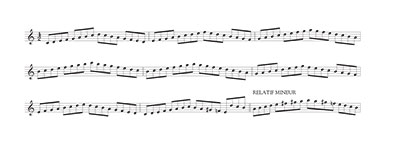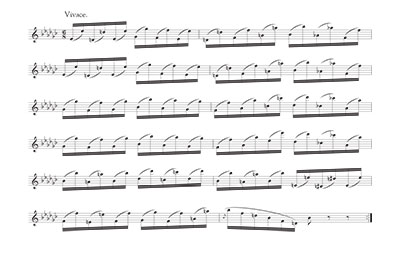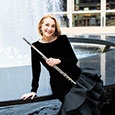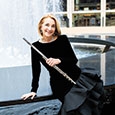I remember distinctly being bowled over the first time I beheld Marcel Moyse’s How I Stayed in Shape (I prefer the actual title in French: Comment J’ai Pu Maintenir Ma Forme) which are a set of exercises that are astoundingly varied and challenging for precisely the task of staying in top playing condition. All of my studies with Moyse were prior to the internet age when there was time for me to work on the extraordinarily meticulous figures he wrote in this book. Since I am fiercely busy with my life and career, I have developed a warm-up technique that works for me and takes just 43 minutes from start to finish. I am completely dependent on this warm up and also suggest many portions of it to my own students.
Before I get the instrument out of the case, I do a 20-minute yoga routine and then some basic stretches specific to the upper arm. I suffered from De Quervain’s tenosynovitis right after my son was born. These particular upper arm exercises and warm-ups take only three to four minutes and have served me well as they have for other players who suffer from tendonitis.
Then I segue into breath awareness. This mindful awareness is facilitated by breathing in through the nose. Breathing through the nose requires more time, so it helps to slow the entire process. I focus on feeling my ribs expanding and my abdomen in constant, active use.
Taffanel & Gaubert No. 5
I begin this exercise slurred to get the airstream to move liberally forward and with ample supply, inflating through the nose to not only filter the air but to supply the instrument with the purest air possible. Resonance is my priority since the flute only can resonate with air in it. My first instrument, the violin, always resonated even with just a tap to the wooden body, not to mention the vibrancy produced when the bow is drawn across the string.
I grew up as a beginning flutist with Moyse’s De La Sonorite. Those simple chromatic descending steps in the first exercise – quarter note to dotted half notes are invaluable, but for me now, I need to get the airstream moving very excitedly as rapidly as in this fast moving scale (see below, Taffanel & Gaubert No. 5). I then repeat it ascending chromatically. Next I repeat with the Ku-ku or Gu-gu syllable. This warms up and activates my tongue.
Time permitting, I include orchestra excerpts that for me are very tricky. These might include the fast Leonore excerpt (measures 328-360), the Mendelssohn Scherzo solo (12 before P to 23 after Q at quarter note = 72), Voliere from Saint-Saens’s The Carnival of the Animals, and the opening of the third movement of the Mozart Concerto in D major.
During this routine, I always do intermittent arm swings with my flute (See Flute Talk, September 2010, p. 20-22, Add Stretches to Practice Sessions). The phrase “Neck free, head forward and up, back lengthening and widening,” is my credo. My treasured aphorism “Don’t let your airstream know what your fingers are doing,” reminds me to always connect with the airstream. I often liberally visualize my string playing years and suggest to myself up bow and down bow. Bow speed parallels flute airstream usage. With all of these ideas and actual implementations, I am reminded of Mr. Moyse’s harkening, “Play with life, Play with life.” My best guarantee for having a fruitful first 30 minutes of practice is to use air very generously and always with forward motion.
A


For these exercises, I alternate playing legato (slurred) and then a rapid double tongued staccato. No. 1, Major


First, I do the entire cycle of keys legato (slurred) and then repeat with a rapidly double tongued staccato. I often change the articulation as well. Every time I need to re-inflate, I inhibit breathing through the mouth and breathe solely through the nose in order to take a slow conscious breath. My wonderful variety pack of changing articulations as I descend and ascend keeps my brain focused and my tongue sharp.

Next I practice #14 from the Theobald Boehm Daily Exercises to get my octaves perfectly in tune and also to secure the flexibility needed in the embouchure and jaw for the octave jumps. At this point, I am assured that I am fully warmed up.

50th Anniversary Season
Carol Wincenc will embark on a 50th Anniversary Season of her New York debut with a series of recitals in the New York area that feature new works by Jake Heggie, Pierre Jalbert, Robert Sirota, Larry Alan Smith and Sato Matsui.
November 12, 2019, 7pm
The Morgan Library & Museum
Carol Wincenc: The Ruby Concerts, documentary film
January 18, 2020
Stony Brook University Staller Center for the Arts
Featuring a work written by Valerie Coleman for the Flute New Music Consortium.
February 23, 2020, 5pm
Merkin Hall, Kaufman Music Center
Wincenc will be the featured guest on “Only at Merkin with Terrance McKnight.” New works by Robert Sirota with Trio Les Amies (Nancy Allen, harp; Cynthia Phelps, viola) and Sato Matsui with pianist Bryan Wagorn.
April 16, 2020, 7pm
Stony Brook University Staller Center for the Arts
Features a new work by Larry Alan Smith for flute, oboe (James Austin Smith), viola (Matthew Lipman), cello (Mihai Marica), and piano (Hsin Chiao Liao). The grand finale is Andrew Thomas’s O Samba with 30 musicians on stage, including 20 flutists.






